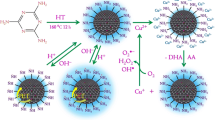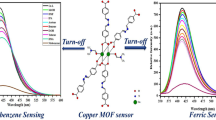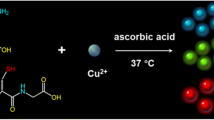Abstract
Since Cu2+ and Fe3+ ions have been considered as bioactive cations in oxygen transport and enzymatic reactions, the development of reliable ways for the monitoring of the two species will be highly desirable. But the optical stability of conventional organic chromophores needs to be improved. Therefore, the employment of quantum dots (quantum dots are abbreviated to be QDs) such as ternary CuFeS2 QDs for the purpose of sensing has been reported in this study. CuFeS2 QDs were synthesized by using oleylamine as the stabilizer at 180 °C and the particle size was around 2–3 nm. The monodispersed quantum dots with tetragonal chalcopyrite crystalline structure were identified. The corresponding excitation and emission wavelengths of the QDs were monitored at 372 and 458 nm. Magnetic properties were analyzed via applied magnetic field ranging between −6000 and 6000 Oe at 300 K and the ferromagnetic phase was verified. In this report, CuFeS2 QDs has been used as an optical probe to detect the metal ions with high sensitivity, selectivity and fast responses. Two linear equations can be obtained in the range from 0 to 30 μM for Cu2+ and from 0 to 45 μM for Fe3+ (detection limits: Cu2+, 1.98 μM; Fe3+, 2.15 μM). These results may provide promising applications in cation sensing fields.













Similar content being viewed by others
References
Al-Achkar M, Scott C (1992) The use of cathodoluminescence in studies of CuxS CdS solar cells. Sol Energy Mater Sol Cells 27:253–263
Alberto LO, Fernández LE, Julián C (2015) Exploring the magnetic properties of cobalt-ferrite nanoparticles for the development of a rare-earth-free permanent magnet. Chem Mater 11:4048–4056
Ananthanarayanan A, Wang X, Li J, Chen P (2014) Facile synthesis of graphene quantum dots from 3D graphene and their application for Fe3+ sensing. Adv Funct Mater 24:3021–3026
Ang R, Atta Ullah K, Naohito T, Ken T, Ryuhei N (2015) Thermoelectricity generation and electron-magnon scattering in a natural chalcopyrite mineral from a deep-sea hydrothermal vent. Angew Chem Int Ed 127:12909–12913
Bhorge Y, Tsai H, Huang K, Pape A, Janaki S, Yen Y (2014) A new pyrene-based Schiff-base: a selective colorimetric and fluorescent chemosensor for detection of Cu(II) and Fe(III). Spectrochim Acta A Mol Biomol Spectrosc 130:7–12
Chen X, Pradhan T, Wang F, Kim JS, Yoon J (2012) Fluorescent chemosensors based on spiroring-opening of xanthenes and related derivatives. Chem Rev 112:1910–1956
Chen MH, Zheng YH, Gao JW, Li C, Yu CF, Wang QM (2017) Fluorometric determination of dopamine by using a terbium (III) inorganic-organic network. Microchim Acta 184:2275–2280
Chen MH, Wen Q, Gu FL, Gao JW, Zhang CC, Wang QM (2018) Mussel chemistry assembly of a novel biosensing platform based on polydopamine fluorescent dot and its photophysical features. Chem Eng J 342:331–338
Dalapati S, Jana S, Alam M, Guchhait N (2011) Multifunctional fluorescent probe selective for Cu(II) and Fe(III) with dual-mode of binding approach. Sensor Actuators B Chem 160:1106–1111
Devi S, Kaur A, Sarkar S, Vohra S, Tyagi S (2018) Synthesis and characterization of highly luminescent N-doped carbon quantum dots for metal ion sensing. Integr Ferroelectr 186:32–39
Devi P, Rajput P, Thakur A, Kim KH, Kumar P (2019) Recent advances in carbon quantum dot-based sensing of heavy metals in water. Trends Anal Chem 114:171–195
Dutková E, Bujňáková Z, Kováča J (2018) Mechanochemical synthesis, structural, magnetic, optical and electrooptical properties of CuFeS2 nanoparticles. Adv Powder Technol 29:1820–1826
Engin TE, Powell AV, Hull S (2011) A high temperature diffraction-resistance study of chalcopyrite, CuFeS2. J Solid State Chem 184:2272–2277
Girma WM, Dehvari K, Ling YC, Chang JY (2019) Albumin-functionalized CuFeS2/photosensitizer nanohybrid for single-laser-induced folate receptor-targeted photothermal and photodynamic therapy. Mater Sci Eng C 101:179–189
Hamajima T, Kambara T, Gondaira K (1981) Self-consistent electronic structures of magnetic semiconductors by a discrete variational X calculation. III. Chalcopyrite CuFeS2. Phys Rev B 24:3349–3353
He Z, Yu S, Zhou X (2010) Magnetic-field-induced phase-selective synthesis of ferrosulfide microrods by a hydrothermal process: microstructure control and magnetic properties. Adv Funct Mater 16:1105–1111
He L, Li J, Xin J (2015) A novel graphene oxide-based fluorescent nanosensor for selective detection of Fe3+ with a wide linear concentration and its application in logic gate. Biosens Bioelectron 70:69–73
Hentze MW, Muckenthaler MU, Galy B (2010) Two to tango: regulation of Mammalian iron metabolism. Cell 142:24
Koneswaran M, Narayanaswamy R (2009) RETRACTED: l-Cysteine-capped ZnS quantum dots based fluorescence sensor for Cu2+ ion. Sensor Actuators B Chem 139:104–109
Kukkar P, Kukkar D, Sammi H, Singh K, Rawat M, Singh P, Basu S, Kim KH (2018a) A facile means for the improvement of sensing properties of metal-organic frameworks through control on the key synthesis variables. Sensor Actuators B Chem 271:157–163
Kukkar D, Vellingiri K, Kumar V, Deep A, Kim KH (2018b) A critical review on the metal sensing capabilities of optically active nanomaterials: limiting factors, mechanism, and performance evaluation. Trends Anal Chem 109:227–246
Kuwar A, Patil R, Singh A, Sahoo S, Marek J, Singh N (2015) A two-in-one dual channel chemosensor for Fe3+ and Cu2+ with nanomolar detection mimicking the IMPLICATION logic gate. J Mater Chem C 3:453–460
Li XQ, Gao JW, Rao SY, Zheng YH (2017) Development of a selective “on-off-on” nano-sensor based on lanthanide encapsulated carbon dots. Synth Met 231:107–111
Li XQ, Zhou Z, Zhang CC, Zheng YH, Gao JW, Wang QM (2018) Ratiometric fluorescence platform based on modified silicon quantum dots and its logic gate performance. Inorg Chem 57:8866–8873
Lin JT, Wang QM (2015) Role of novel silicon nanoparticles in luminescence detection of a family of antibiotics. RSC Adv 5:27458–27463
Liu X, Zhang N, Bing T (2014) Carbon dots based dual-emission silica nanoparticles as a ratiometric nanosensor for Cu2+. Anal Chem 86:2289–2296
Lou YB, Zhao YX, Chen JX, Zhu JJ (2014) Metal ions optical sensing by semiconductor quantum dots. J Mater Chem C 2:595–613
Lu D, Tang YP, Gao JW, Chen Y, Wang QM (2019) Green anhydrous assembly of carbon dots via solar light irradiation and its multi-modal sensing performance. Dyes Pigments 165:287–293
Lyubutin IS, Lin CR, Starchikov SS (2013) Synthesis, structural and magnetic properties of self-organized single-crystalline nanobricks of chalcopyrite CuFeS2. Acta Mater 61:3956–3962
Ma QM, Wang QM (2015) Lanthanide induced formation of novel luminescent alginate hydrogels and detection features. Carbohydr Polym 133:19–23
Mahmoud W, Yaghmour S (2013) Synthesis, characterization and luminescence properties of thiol-capped CdSe quantum dots at different processing conditions. Opt Mater 35:652–656
Ndokoye P, Ke J, Liu J, Zhao Q, Li X (2014) L-cysteine-modified gold nanostars for SERS-based copper ions detection in aqueous media. Langmuir 30:13491–13497
Ortega S, Ibáñez M, Liu Y (2017) Bottom-up engineering of thermoelectric nanomaterials and devices from solution-processed nanoparticle building blocks. Chem Soc Rev 46:3510
Que EL, Domaille DW, Chang CJ (2018) ChemInform Abstract: Metals in neurobiology: probing their chemistry and biology with molecular imaging. Cheminform 108:1517
Salgado JC, Olivera-Nappa A, Gerdtzen ZP (2017) Mathematical modeling of the dynamic storage of iron in ferritin. BMC Syst Biol 4:147
Sheng X, Liu Y, Wang Y (2017) Cesium lead halide perovskite quantum dots as a photoluminescence probe for metal ions. Adv Mater 29:1700150
Silvi S, Credi A (2015) Luminescent sensors based on quantum dot-molecule conjugates. Chem Soc Rev 44:4275–4289
Singh K, Kukkar D, Singh R, Kukkar P, Kim KH (2018) Exceptionally stable green-synthesized gold nanoparticles for highly sensitive and selective colorimetric detection of trace metal ions and volatile aromatic compounds. J Ind Eng Chem 68:33–41
Tang K, Ma QM, Zhan QG, Wang QM (2014) An intelligent copper (II) luminescent sensor using europium narrow emissions based on titania hybrid material. Opt Mater 36:1520–1524
Wang ZS, Lin JT, Gao JW, Wang QM (2016) Two optically active molybdenum disulfide quantum dots as tetracycline sensors. Mater Chem Phys 178:82–87
Wang Y, Lao S, Ding W, Zhang Z, Liu S (2019) A novel ratiometric fluorescent probe for detection of iron ions and zinc ions based on dual-emission carbon dots. Sensors Actuators B Chem 284:186–192
Wen LL, Zheng XF, Lv KL, Wang CG, Xu XY (2015) Two amino-decorated metal–organic frameworks for highly selective and quantitatively sensing of HgII and CrVI in aqueous solution. Inorg Chem 54:7133–7135
Weng Z, Wang H, Li R, He J, Yang W (2013) Self-assembly of core-satellite gold nanoparticles for colorimetric detection of copper ions. Anal Chim Acta 803:128–134
Wu P, Wang S (2013) Semicondutor quantum dots-based metal ion probes. Nanoscale 6:43–64
Yang L, Zhu W, Fang M, Zhang Q, Li C (2013) A new carbazole-based Schiff-base as fluorescent chemosensor for selective detection of Fe3+ and Cu2+. Spectrochim Acta A Mol Biomol Spectrosc 109:186–192
Yu AW, Zeng Z, Luo Q, Gao JW, Wang QM (2018) Establishment of a new analytical platform for glucose detection based on a terbium containing silica hybrid nanosensor. Appl Surf Sci 462:883–889
Yu HJ, Xu JH, Li J (2019) Synthesis and characterization of CuFeS2 and Se doped CuFeS2−xSex nanoparticles. J Mater Sci Mater Electron 30:12269–12274
Zhang L, Wang E (2014) Metal nanoclusters: new fluorescent probes for sensors and bioimaging. Nano Today 9:132–157
Zhang JJ, Kang TF, Hao YC, Lu LP, Cheng SY (2015) Electrochemiluminescent immunosensor based on CdS quantum dots for ultrasensitive detection of microcystin-LR. Sensor Actuators B Chem 214:117–123
Zhou Z, Wang QM, Zeng Z, Yang LT, Ding XP, Lin N, Cheng ZS (2013) Polyurethane-based Eu(III) luminescent foam as a sensor for recognizing Cu2+ in water. Anal Methods 3:6045–6050
Zhou Z, Wang QM, Wang JY, Zhang CC (2015) Imaging two targets in live cells based on rational design of lanthanide organic structure appended carbon dots. Carbon 93:671–680
Zuo PL, Lu XH, Sun ZG, Guo YH, He H (2016) A review on syntheses, properties, characterization and bioanalytical applications of fluorescent carbon dots. Microchim Acta 183:519–542
Funding
J. W. thanks supports from National Natural Science Foundation of China-Guangdong Joint funding support (U1801256). X. B. is grateful to the support from the project for Guangdong Province University and Colleges Pearl River Scholar Funded Scheme (2016). X. Y. thanks for the support of Innovation Project of Graduate School of South China Normal University (2018LKXM028).
Author information
Authors and Affiliations
Corresponding authors
Ethics declarations
Conflict of interest
The authors declare that they have no conflict of interest.
Additional information
Publisher’s note
Springer Nature remains neutral with regard to jurisdictional claims in published maps and institutional affiliations.
Rights and permissions
About this article
Cite this article
Wu, N., Liu, X., Zeng, M. et al. Controllable synthesis of novel luminescent CuFeS2 quantum dots with magnetic properties and cation sensing features. J Nanopart Res 21, 268 (2019). https://doi.org/10.1007/s11051-019-4709-9
Received:
Accepted:
Published:
DOI: https://doi.org/10.1007/s11051-019-4709-9




